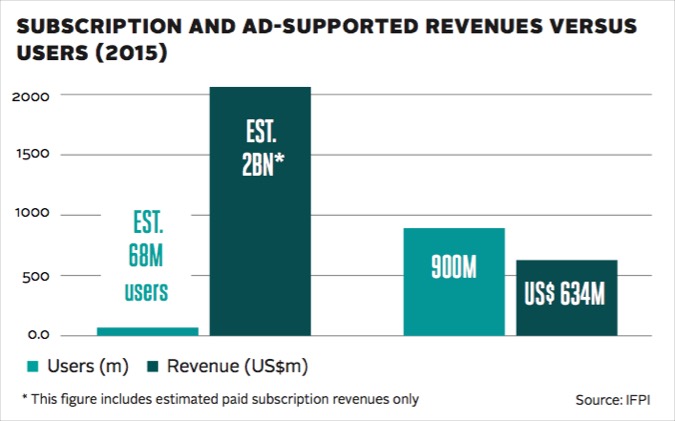-
Global Music Industry Targets YouTube Over 'Value Gap' Revenue Shortfall
The global recorded music industry generated $15 billion in revenue in 2015, a 3.2% year-over-year improvement, its first meaningful gain in nearly 20 years, according to the International Federation of the Phonographic Industry’s new Global Music Report. But rather than celebrating, the IFPI is emphasizing that a “value gap,” created by YouTube and other upload/sharing sites, is sapping the industry of much-needed revenue.
The IFPI illustrated the value gap by noting that 900 million users worldwide access free, ad-supported, on-demand music sites, yet these companies account for just 4%, or $634 million, of the industry’s 2015 licensing revenues. That contrasts with subscription streaming services, which contributed 19%, or $2.9 billion, of the industry’s revenues, though there are only 68 million subscribers (note, the IFPI estimates that $2 billion of this is directly attributable to paid subscriptions, with the balance coming from ads in these services’ free tiers).

Subscriptions have become an extremely important part of the industry’s revenue mix. Subscriptions’ share is up over 4x in the past 5 years and accounts for 43% of the industry’s digital revenues, slightly behind the 45% contributed by downloads, which continued to decline in 2015, by 10.5%.
The IFPI is asserting that the value gap is created by free ad-supported services like YouTube evading or paying below market licensing fees by claiming “safe harbor” protection. The music is placed on these sites by users or artists themselves, eager for the promotional value of being freely available to massive audiences. This allows YouTube and others to gain access to the content without first having to negotiate licensing fees, which in turn strengthens its leverage when negotiations do occur.
The IFPI believes the “safe harbor” rules are being misapplied as they were originally meant to protect passive companies from copyright infringement, but are instead now being used to shield profit-driven businesses. IFPI says that in 2014, Spotify paid licensing fees of $18 per user whereas YouTube paid less than $1 per user. The WSJ quoted a statement from YouTube saying it has “paid out over $3 billion to the music industry.”
It’s a complicated situation. Laws and their intent clearly need to be abided by and artists have every right to be paid fair market rates. But YouTube’s sheer size and reach make it an anomaly, offering promotional power to artists that is hard to replicate elsewhere. And YouTube’s Content ID feature allows artists to have their music taken down if they want to.
All of this leaves a situation that is unlikely to be fully resolved any time soon. The IFPI is organizing the industry and working with regulators to address the value gap. It pointed to a December, 2015 paper by the European Commission that acknowledged the value gap is a problem and plans by the EC to publish its first proposals in 2016.The Global Music Report 2016 is available for complimentary download.
Categories: Music

